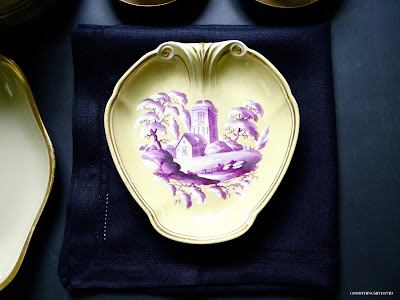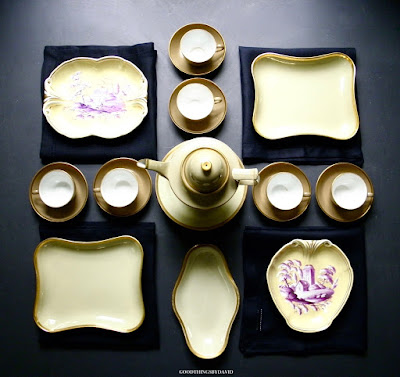It isn't unusual or unheard of to encounter antishoplifting tags on items at antique stores, antique malls and consignment shops. Security stickers on antique and vintage pieces can be problematic if the adhesive is particularly strong or if the tag has been on the item for a number of years.
Antishoplifting tags are made by embedding layers of metal coil resonators within nonconductive materials. These tags will transmit a signal to the security gates if they have not been deactivated. This is good if you are the antique shop owner, but bad news if you're the buyer.
Depending on the type of piece you've purchased, Goo Gone Original can be life changing. If you collect fine china, keeping a bottle of this adhesive removal product in your home is a must. All high end antique stores & vendors will have security tags on their precious objects, so be prepared.
Several years ago I came across several pieces of antique Wedgwood drabware from the early 1800s at a high end antique store that I could not walk away from. Call it fate, call it good luck. I think it was meant to be. What I wasn't expecting, though, was to have antishoplfting tags that seemed to be fused to the undersides of my plates and serving dishes. As annoyed as I was, I knew that I had to treat my treasures gently if I wanted them to remain undamaged.
You can see my pathetic attempts at removing these tags by trying to peel them off of the gilded drabware dessert plates. The paper peeled off, but the remaining materials didn't want to budge. They were tough. I asked several of my friends what they would do. Some suggested Goo Gone, and others suggested peanut butter.
Note: read the directions and warnings on the bottle, and always test this product before using it.
Do you see the imprint? It says "drab porcelain".
Antishoplifting tags are made by embedding layers of metal coil resonators within nonconductive materials. These tags will transmit a signal to the security gates if they have not been deactivated. This is good if you are the antique shop owner, but bad news if you're the buyer.
Depending on the type of piece you've purchased, Goo Gone Original can be life changing. If you collect fine china, keeping a bottle of this adhesive removal product in your home is a must. All high end antique stores & vendors will have security tags on their precious objects, so be prepared.
 |
| Antique Wedgwood Drabware Dessert Plates ca.1820 |
You can see my pathetic attempts at removing these tags by trying to peel them off of the gilded drabware dessert plates. The paper peeled off, but the remaining materials didn't want to budge. They were tough. I asked several of my friends what they would do. Some suggested Goo Gone, and others suggested peanut butter.
 |
| Antique Wedgwood Drabware Plate |
I started by removing as much of the label as possible without resorting to anything. The paper part was easily removed, but the metal coils were impossible. I tested one plate before making sure that the Goo Gone was going to work without damaging my antiques.
Working in my kitchen next to the sink, I laid each plate on a clean, soft kitchen towel. I then soaked a cotton ball in Goo Gone and applied it liberally over the entire tag. This was then left to soak for about 5 minutes. I then used a plastic bench scraper to gently remove the tags. Most of them were able to come off, but a few were rather stubborn, so I reapplied more Goo Gone until the metal coils came off. Thankfully it worked!
Each piece was then carefully washed in warm water with a mild dish soap to remove any excess product. After I hand dried each plate and serving dish, I inspected them for any scratching or color damage, but I detected nothing.
Note: read the directions and warnings on the bottle, and always test this product before using it.
 |
| Lakin Pottery Drabware ca. 1810 |
This unusual drabware serving dish from ca. 1810 is not Wedgwood. The gilded piece has a handpainted landscape scene in lovely shades of plums and creams. The scrolled edges are accented in thick bands of gold. I love it so much.
Do you see the imprint? It says "drab porcelain".
 |
| Lakin Pottery Drabware ca. 1810 |
Here is another early nineteenth century gilded drabware serving dish with a landscape scene in the same shades as the previous piece. Simply beautiful!
The imprint of this serving dish says 'Lakin'. What this means is that both pieces were produced by none other than the North Staffordshire pottery works of Thomas Lakin, sometime in the early 1800s. Thomas Lakin Pottery began producing pieces in the late 1700s and continued to do so through the early part of the nineteenth century. Undamaged pieces such as these are indeed treasures.
A mix of antique Wedgwood, Lakin and Spode drabware.
The stamp of early Wedgwood is unmistakable.
The thrill of the hunt for unique and rare pieces of fine china doesn't have to be thwarted by a simple security sticker or tag. Having a bottle of goo gone will have your pieces ready for display on a wall, a cabinet, a breakfront in the dining room or an heirloom hutch in the kitchen. Remember: antiques are meant to be shared, so display and enjoy them!






Thank you for this terrifically useful post. It is so good that you have reminded us about the versatility and utility of Goo Gone.
ReplyDeleteI will not forget!
You are welcome!
DeleteI've used coconut oil with and without some baking soda mixed in with very good results. Just fyi. Beautiful pieces!
ReplyDeleteHow interesting Trina!! Thanks for the info. I'll keep it in mind for the future.
Delete